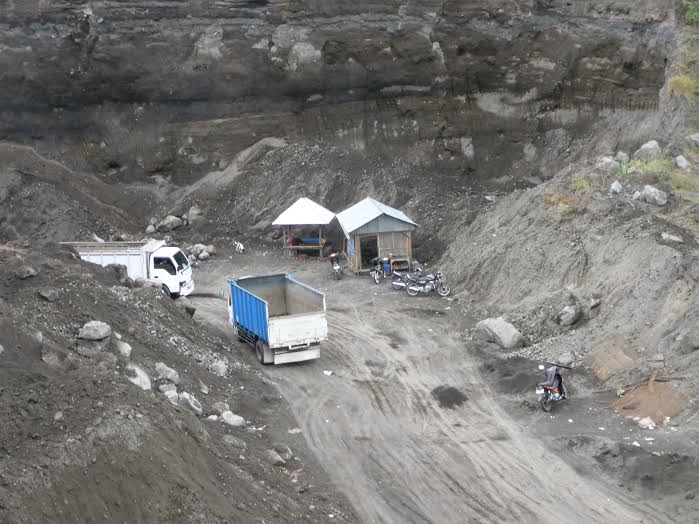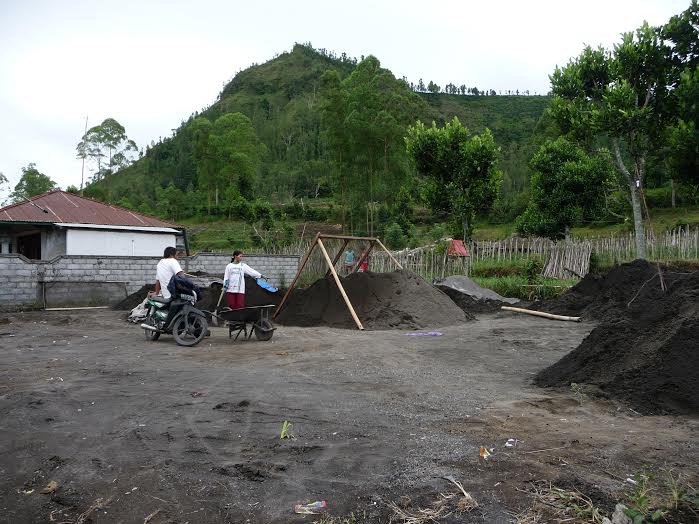Beyond the tourism and real estate frontiers in Bali is a small branch of the global resource frontier.
Graeme MacRae
Resource stripping in Batur, Bali - Graeme MacRae
A few weeks ago, I drove up the Sidemen road, famous since the 1930s as one of the most beautiful in Bali. I would have taken it slowly anyway, to enjoy the views, but I had no choice. Around 200 trucks were coming the other way, down from the mountains, overloaded with sand, gravel and rock.
Where were they coming from? Where were they going to?
They come from quarries on the slopes of the sacred mountain Agung. They are headed where everything else is headed: into the hundreds of hotel, villa and other construction projects. Most are in Bali’s coastal resorts, but some are on ricefields around the sprawling urban area of Denpasar/Kuta.
A few days later, I meet a similar procession coming down the other sacred mountain, Batur. This time I learn a bit more. Every day, from before dawn till after dusk, at least 1500 overloaded trucks grind their way painfully up out of the crater, stopping on the way to offload excess weight.
Down in the caldera, amid what is left of a rich but delicate ecosystem of wild grasses and orchids which feed off volcanic ash among spectacular fields of black lava, lies one of the far outposts of the global resource economy.
Piles of black gravel line the narrow road around the caldera floor. Alongside it are makeshift shelters under which men and women shovel gravel through large sieves into piles of finer sand. When the sieving is done, they flag down a truck and load it by hand. Signs invite trucks into a hinterland of even narrower dirt tracks where more piles are waiting. Each hamlet the trucks pass through shares in the boom by levying its own little toll.
But where does all this black stuff come from in the first place?
Some of it is dug by hand from what were probably blowholes on the side of the volcano, now in people’s backyards. But here and there this landscape of backyard industry expands into something bigger. Tracks lead down into pits 20 metres or more deep, and up to 100 metres wide. At the bottom, large diggers drop buckets of gravel onto monster versions of the roadside sieves, then into waiting trucks. These pits spread until they threaten to undermine houses, villages, schools, and even temples, which now sit precariously atop cliff-faces.
The villages strung along the roadsides are black and dusty, bleak and treeless – no tourist comes here and the only water arrives by truck. But between them, in places close enough for water to be pumped from lakes or springs, lie vegetable gardens and orchards. If you venture off-road into the labyrinth of tracks, more emerge: fields of tomatoes, cabbages, onions and enormous orange pumpkins. There are even moments where beautiful micro-landscapes of gardens, trees and little bamboo houses offer glimpses of what once was, and of what a sustainable future might look like (at least until the next eruption).
But this is only half the story. Horticulture is the other viable economic option for a rapidly growing population, and in this area forest regrowth is now being cut on the lower crater walls to clear more fields. The eroded topsoil is silting up the lake and raising water levels. At the same time, runoffs of petrochemical fertilisers, fungicides and pesticides find their way into the lake, which is lined with fish farms using synthesised food laced with antibiotics. Together, these have increased nutrient loads in the water which feed an invasion of water hyacinth, while DDT and other toxins have caused deformities in fish. So far, no similar effects have been recorded in humans or animals dwelling on the lake shores, but they are obviously also at risk.
There are two main communities in the crater: Batur, whose village and main temple was shifted from the floor to the rim of the crater after an eruption in 1926, but which retains traditional ritual jurisdiction over the western half of the crater; and Songan, a larger village by the eastern end of the lake, which has, until recently, had less resources and economic development than Batur. But the new resource rush has changed that, with most of the quarrying and trucking being done by people from Songan. Most, if not all, of it is illegal. Not everybody in Batur is happy with this new wildcat economy. But nobody has the authority to stop it.
Responsibility for environmental protection and development lies with the district government, down the hill in Bangli. The staff at the visitor booth collecting fees levied by the district government, recite a litany of environmental and infrastructural problems that are not being remedied by a government flush with new revenues. Likewise, the local police and army post say they are prepared to stop the quarrying and trucking, but only at the direction of the government. The lake and its temple are also part of a UNESCO World Cultural Heritage listing, and the whole crater is part of a UNESCO Global Geopark. Both are likewise supposed to be managed by the district government. To date, the governing bodies required by these designations have not even been established.
But there are other sources of authority in Batur. Both Songan and Batur have temples called Puru Ulun Danu. The one in Batur is generally recognised as one of the main temples of Bali and a kind of control centre for the irrigation water for most of the island. It is presided over by a pair of non-Brahman priests who are considered the spiritual leaders of the community. One of them, Jro Gede Alitan, has used his spiritual authority to encourage and facilitate environmental awareness and conservation around the crater. Any quarrying or forest cutting visible from the temple results in a polite visit by a delegation from the temple. Few would dare continue in the face of disapproval from Jro Gede.
 Resource stripping in Batur, Bali - Graeme MacRae
Resource stripping in Batur, Bali - Graeme MacRae
Likewise, Jro Gede has restored and revitalised a circle of temples on the crater floor, mostly located at strategic ecological points such as the outlets of watercourses, to define sacred zones that likewise few would dare violate. On his own land near the crater wall, he has planted a row of onion beds above which nobody has yet been prepared to cut forest. These and other strategic interventions have limited the damage, but anywhere out of direct sight of the temple remains fair game. At the other end of the crater, his jurisdiction gives way to that of Songan, where different values prevail and support for the present district government is high.
Yet, Jro Gede’s authority stems ultimately from a still higher source.
According to Jro Gede, Batur is ‘not just a lake, but the garden of Dewi Danu (the Goddess of the lake) and the god Wisnu’, on whom Bali’s entire water and ecosystem depends. In mid-2011, the water of the lake suddenly changed colour and soon after thousands of the farmed fish died. The official explanation was the release of a plume of sulphur from an underwater volcanic vent. Others say that it was the goddess cleansing the lake of pollution.
A few months later, in the wet season of 2011-12, heavy rains caused landslides of deforested slopes at the edge of the crater. The lake level rose, exacerbated by the silting, and significantly, on the eve of Nyepi (the Balinese day of silence), Songan began to flood. Most inhabitants evacuated up to Penelokan on the crater rim but returned when the rains abated next morning, to observe Nyepi in the seclusion of their sodden homes. Since then, there has been a noticeable increase in ritual activity and religious fervour throughout the crater community.
What is happening in Batur is an unprecedented rush for resources reminiscent of the wild west, or elsewhere in Indonesia, the environmental destruction on the resource frontier in Southeast Kalimantan, so brilliantly documented by Anna Tsing in her book, Friction. While the people of Batur compete with each other to strip their own resources and grab what they can before it all runs out, the causes lie further afield. The original wild west and all those since have been driven by demand for resources and enabled by lack of government control. Half an hour downhill from Batur in Bangli, government inaction drives this resource drain. An hour further is another frontier where centuries-old rice fields are being converted by the hour into a sea of villas, hotels and resorts. The sand and rock frontier in Batur is one of the upstream ends of the many supply chains feeding this construction boom.
On the other side of the construction frontier are the supply lines of investment money, flowing from Jakarta and overseas. While resource frontiers such as Batur may look like failures of local behaviour, they are the inevitable products of money being made somewhere else and of those in charge allowing it to happen. Batur’s Jro Gede is old and his health is failing. He has done what he can. But in his view, if the government does not fulfil its responsibilities, the Goddess might just do it for them.
Graeme MacRae (G.S.Macrae@massey.ac.nz) teaches anthropology at Massey University, Auckland.
Other related articles from the II archive:
'Mining Paradise'. Tessa Toumbourou
'Campaigning for Agrarian Reform'. Eve Warburton
'Deforestation, rent seeking and local elections in West Kalimantan'. Danang Widoyoko
Inside Indonesia 117: Jul-Sep 2014
{jcomments on}
